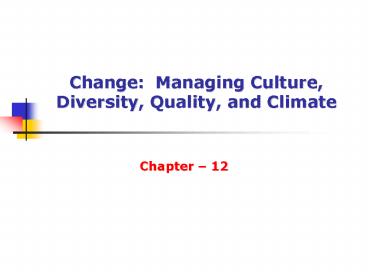Change: Managing Culture, Diversity, Quality, and Climate - PowerPoint PPT Presentation
1 / 27
Title:
Change: Managing Culture, Diversity, Quality, and Climate
Description:
The survey data are analyzed to uncover problem areas for improvement. ... The change agent feeds back the results to management. ... – PowerPoint PPT presentation
Number of Views:105
Avg rating:3.0/5.0
Title: Change: Managing Culture, Diversity, Quality, and Climate
1
Change Managing Culture, Diversity, Quality,
and Climate
- Chapter 12
2
Learning Objectives
- Explain why managing change skills are important.
- Describe the four types of changes.
- State why people resist change and how to
overcome it. - Explain how to use a change model when making
changes. - Explain dimensions of an organizations culture.
3
Learning Objectives
- Describe how diversity and quality are dimensions
of organizational culture. - Explain dimensions of an organizations climate.
- Describe five OD techniques.
- Explain the relationship among organizational
culture, diversity, quality, climate, and
development.
4
Types of Changes
- Technological change
- Structural change (reengineering)
- The way the firm is organized to meet its mission
and objectives - Task change
- Behavior to complete the organizational change
- People change (socio-technical)
- Employees who complete the tasks
5
Types of Changes
- Technological change
- Machines
- Process
- Management Information Systems (MIS) are formal
systems for collecting, processing, and
disseminating information necessary to aid
managers in decision making. - Automation is the simplification or reduction of
human effort to de a job.
6
Change Process Stages
Denial Resistance Exploration
Commitment
7
Resistance to ChangeVariables
- Intensity
- Acceptance
- Tolerance
- Resistance (weak to strong)
- Rejection
- Source
- Facts
- Beliefs
- Values
- Focus
- Self
- Others
- Work environment
8
Hultmans Resistance Matrix
9
Overcoming Resistance to Change
10
Change Models
- Lewins Change Model
- Step 1. Unfreezing (providing information that
shows discrepancies between desired
performance and actual performance) - Step 2. Moving (shifting the behavior to a new
model, learning new desirable behavior,
values, attitudes) - Step 3. Refreezing (desirable performance
becomes the permanent way of doing things)
11
Change Models
- Lussiers Change Model
- Step 1. Define the change.
- Step 2. Identify possible resistance to
change. - Step 3. Plan the change.
- Step 4. Implement the change, Give the facts.
- Involve employees. Provide support.
- Step 5. Control the change (reinforcement of
change.)
12
Organizational Culture
- Consists of the shared values and assumptions of
how its members will behave. - Is the relatively enduring quality of the
internal environment of the organization
perceived by its members. - Morale a state of mind based on attitudes and
satisfaction with the organization.
13
Organizational Culture
- Strong
- Clear
- Positive
- Contributes to effective performance and
productivity. - Weak
- Unclear
- Negative
- Source of resistance and turmoil that hinders
effective performance.
14
Managing Diversity and Quality
- Valuing diversity emphasizes training employees
of different ages, sexes, and races to function
effectively together. - Managing diversity emphasizes meeting all
employee needs. - Total quality management (TQM) promotes a culture
in which everyone in the organization strives for
continual improvement in all dimensions of
operations.
15
Quality
- Quality the predetermined standard that the
product or service should meet. - Quality in Organizations
- Total Quality Management (TQM)
- ISO 9000
- Six Sigma
16
Common Dimensions of Climate
- Structure The degree of constraint on
membersthe number of rules, regulations, and
procedures. - Responsibility The degree of control over ones
own job. - Rewards The degree of being rewarded for ones
efforts and being punished appropriately.
17
Common Dimensions of Climate
- Warmth The degree of satisfaction with human
relations. - Support The degree of being helped by others and
of experiencing cooperation. - Organizational identity and loyalty The degree
to which employees identify with the organization
and their loyalty to it. - Risk The degree to which risk taking is
encouraged.
18
Organizational Development
- Is the ongoing planned process of change used as
a means of improving the organizations
effectiveness in solving problems and achieving
its objectives. - Five OD techniques
- Training and development
- Grid OD
- Survey feedback
- Force field analysis
- Team building
19
Organizational Development Training and
Development
- Step 1. Needs assessment
- Step 2. Set objectives
- Step 3. Prepare for training
- Step 4. Conduct the training
- Step 5. Measure and evaluate training results
20
Organizational Development Grid OD
- Grid OD a six-phase program designed to improve
management and organizational effectiveness. - Phase 1. Training
- Phase 2. Team development
- Phase 3. Inter-group development
- Phase 4. Organizational goal setting
- Phase 5. Goal attainment
- Phase 6. Stabilization
21
Organizational Development Survey Feedback
- Survey feedback an OD technique that uses a
questionnaire to gather data that are used as the
basis for change.
22
Organizational Development Survey Feedback
Technique
- Management and the change agent do some
preliminary planning to develop an appropriate
survey questionnaire. - the questionnaire is administered to all members
of the organization/unit. - The survey data are analyzed to uncover problem
areas for improvement.
23
Organizational Development Survey Feedback
Technique
- The change agent feeds back the results to
management. - Managers evaluate the feedback and discuss the
results with their subordinates. - Corrective action plans are developed and
implemented.
24
Organizational DevelopmentForce Field Analysis
- Force field analysis a technique that diagrams
the current level of performance, the hindering
forces toward change, and the driving forces
toward change.
25
Organizational DevelopmentForce Field Analysis
26
Organizational DevelopmentTeam Building
- Team building is an OD technique designed to
help work groups operate more effectively - Goals effective and efficient
- Responsibilities
- Program Agenda
- Climate building
- Process and structure evaluation
- Problem identification
- Training
- closure
27
Change Managing Culture, Diversity, Quality,
and Climate
- Chapter 12
- Questions, Comments???































